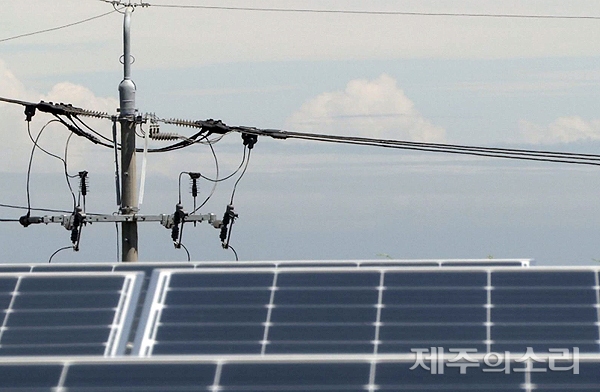[초점] Shutdown 77 times in 2020 due to over-production of electricity… Breakthrough by building decentralized energy infrastructure

[제주의소리]As reported on September 9, 2020 [태풍에도 돌렸는데 제주 풍력발전 45차례 강제 셧다운 왜?] Regarding the controversy, the government decided to actively promote a distributed energy policy in Jeju.
Minister of Trade, Industry and Energy Sung Yun-mo unveiled the energy dispersal plan at the’regional-led measures to revitalize distributed energy’ held at the New Renewable Energy Promotion Center in Jeju Island at 3 pm on the 3rd.
Jeju Island announced its vision of’Carbon Free Island (CFI)’ in 2012 and set an ambitious goal of converting 100% of electricity demand in the province to renewable energy by 2030.
The share of renewable energy generation facilities, which accounted for 9% of the proportion of power generation facilities in the province in 2009, soared from 10% in 2013 to 49% in 2019. The share of power generation also rose from 3% in 2009 to 16.2% in 2020.
On the other hand, the power generated by wind turbines could not be stored or transmitted, and power generation was forcibly shut down.

Most wind power generators in the province have low ESS (Energy Storage System) capabilities, so they consume electricity at the same time as they generate power.
Therefore, when the power supply exceeds the demand, the output is controlled to prevent overload.
The actual number of shutdowns per year and the amount of control increased sharply from 3 in 2015 (152MWh), 14 in 2017 (1300MWh) and 46 in 2019 (9223MWh) to 77 in 2020 (19,449MWh).
To solve this problem, stable output control to prevent overload by expanding ESS facilities to store energy or sending remaining electricity to other areas must be achieved.
In the case of high-performance ESS, the cost of equipment is high, so investors are reluctant to use it. There are no facilities to send electricity to other areas.
In a hurry, the government considered a forced shutdown of solar power facilities following wind power. If the KEPCO requests the KEPCO, it is possible to control the output of the photovoltaic facility.
Minister of Trade, Industry and Energy Sung Yun-mo’s visit to Jeju was to solve such a problem. KEPCO President Kim Jong-gap and Korea Energy Agency Chairman Kim Chang-seop, etc., were dispatched together to inform the seriousness of the situation.

The government’s countermeasure is energy dispersal. The key to this countermeasure is a transaction permit between producers and consumers, demonstration of technology for converting surplus power, and securing the performance of sending surplus power to land.
The 1st connecting line (Jeju Samyang-dong ~ Jeonnam Haenam) 150,000kW class built in 1998 and the 2nd connecting line (Jeju Haeandong ~ Jeonnam Jindo) 250,000kW class are one direction supplying electricity from land System.
If the facility improvement work is undertaken, it is possible to send over-produced electricity from Jeju to land. The Ministry of Commerce, Industry and Energy is conducting a test to send actual power to the land to secure the reverse transmission performance.
It also decided to speed up the establishment of the third linkage line, which provides free power in both directions. KEPCO plans to complete the construction of a 20kW-class connection line by 2022 with a total project cost of 230 billion won.
The Ministry of Commerce, Industry and Energy decided to promote a demonstration project in Jeju that converts surplus renewable energy into hydrogen or uses electric vehicles as ESS.
It also decided to allow a special case for power transactions in which solar and wind power generators directly sell electricity to consumers without going through the power exchange. To this end, it is considering enacting the’Special Act for Activating Distributed Energy’.
The Ministry of Commerce, Industry and Energy said, “We will form a council in Jeju to smoothly implement regional-led measures to revitalize distributed energy,” and “we will also establish and announce a roadmap for this in the first half.”
Copyright © Jeju Insori Unauthorized reproduction and redistribution prohibited
